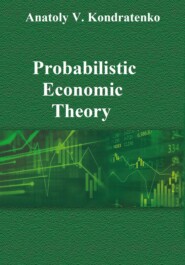По всем вопросам обращайтесь на: info@litportal.ru
(©) 2003-2025.
✖
Probabilistic Theory of Stock Exchanges
Настройки чтения
Размер шрифта
Высота строк
Поля
Note that since we neglect all probabilistic effects in classical theory, or classics, we do not consider the uncertainty and probability principle in classics, although it is clear that it plays an important role in probabilistic theory. It is hardly worth seriously discussing which of these two theories is better. As in the case of classical and quantum mechanics, it is preferable to talk about different applications of classical (in a certain sense deterministic) and probabilistic theories, as we will demonstrate more than once below. Let us remind you that the classical theory in this book refers simply to an initial approximation of the probabilistic theory in which the principle of uncertainty and probability are not explicitly taken into account.
Thus, we will thoroughly describe this approach to the study of the economy dynamics, or evolution, within the framework of the classical economy using the example of the simplest model, namely, a market with one buyer and one seller selling one commodity, such as grain. The economic space in this case is obviously two-dimensional.
1.6.1. DISCRETE STRATEGY OF MARKET AGENTS
Let’s consider a typical situation in a market, which has a real potential buyer and seller of a certain good, say, grain. The buyer wants to buy goods in quantity q
at price p
, and the seller wants to sell goods in quantity q
at price p
. These four parameters fully characterize the state of the market in the classical economy at each point in time. It is commonplace in the market that both prices and quantities of buyer and seller do not coincide. Therefore, if they both insist on their bid and ask, respectively, there will obviously be no deal. The oldest, well-established mechanism for resolving such trade disputes over the years since the emergence of markets is that the buyer and seller enter into trade negotiations with the aim of getting them to agree to a sale and purchase deal on terms that suit both parties. Let us describe this negotiation process in mathematical language as follows. Let the functions p
(t) and q
(t) denote the price and quantity of goods desired and offered by the buyer for buying during negotiations with the seller at a certain time t. Similarly, let the functions p
(t) and q
(t) denote the price and quantity of the good desired and offered by the seller for sell during negotiations with the buyer in the market. In their meaning, the values of prices and quantities introduced above are the main content of agent proposals to buy or sell the goods. Below, for brevity, we will denote these desired and offered values as buyer’s and seller’s quotations. And such a line of agents' behavior in the market will be called a discrete or point strategy, since at each time t these quotes are represented by one point in two-dimensional space, for example, point A with coordinates p
(t) and q
(t) for the buyer and point B with coordinates p
(t) and q
(t) for the seller, as presented in Fig. 1.2.
These quotations are made, of course, taking into account all the circumstances affecting the market operation: institutions, etc. In our view, quotations made by market agents are the essence of the main market phenomenon of classical economic theory in the view of the Austrian economic school, namely the market process [Mises, 2005], consisting of specific acts of choice and actions of market agents, which ultimately lead buyers and sellers to the conclusion of purchase and sale transactions. Graphically, we can depict these quotations as trajectories of agents' movement in economic space (Fig. 1.3). In real market life, these quotations are discrete time functions, but, for the sake of simplicity, we will depict them graphically (just like the S&D functions) as continuous straight lines. Such an approximation does not lead in this case to a loss of generality, because these functions are intended only to illustrate the most general details of the market mechanism and the way they are described (see Fig. 1.3). In their economic sense, such diagrams characterize the temporal dynamics of the market.
Fig. 1.2. Graphical representation of the discrete strategy of buyer’s and seller’s market behavior represented by the two points, A(p
, q
) and B(p
, q
), in the two-dimensional price-quantity space at some particular moment in time for the model grain market. p
= 280,0 $/ton, q
= 50,0 ton/year, p
= 285,0 $/ton, q
= 52,0 ton/year.
We will speak (for the sake of brevity) of this aggregate agents’ movement as market behavior, and sometimes as the economy evolution over time. All these terms are essentially synonymous in this context of discussion. Thus, by putting up desired prices and quantities as their quotations, buyers and sellers take part in the market process, proceeding here in the format of negotiations between bargaining people (homo negotians) seeking to bargain for the best terms for themselves in concluding a deal and achieving market goals. Let us note that in reality the actions of market agents include the procedures of concluding final deals along with quotations, but these procedures are automatically accounted by means of changing quotations by market agents after the conclusion of deals. Therefore, there is no need to Explicitly include the procedure of concluding transactions in the structure of agents' actions, it is enough to take into account only the quotation process in the course of trading.
Fig. 1.3. Diagram of buyer and seller trajectories. The dynamics of the classical two-agent market economy in the economic space of price (a) and quantity (b) is depicted. Together, both parts of the figure represent the evolution of the economy over time in two-dimensional PQ-space.
This whole trading process, or simply bargaining, can be interpreted as a dynamic business exchange game between buyer and seller with the purpose of making a profit or achieving some other goal.
1.6.2. CONCEPT OF ECONOMIC EQUILIBRIUM IN CLASSICS
Let’s suppose that the negotiations went well and ended with the conclusion of a sale and purchase deal at time t
. This means that at that moment in time the values of prices (p
(t) and (p
(t)) and quantities (q
(t) and (q
(t)) in the quotations become equal, since obviously only specific mutually agreed price р
and quantity q
of goods can be specified in the contract. Let us assume that in this bargaining model it makes some sense to call these price and quantity values the market price and quantity of the commodity and to assume that the market itself comes to or reaches its equilibrium state at these price and quantity values. Formally, this is described using the following equations for the market price and quantity:
So, for the two-agent model we obtained this trivial but significant result: the very fact of reaching equilibrium makes it possible to conduct a transaction and maximize the volume of trades in monetary terms. In this simple case the conclusion is quite obvious: no agreement, no equilibrium, no transaction, trading volume is zero. But we will further show that this conclusion has a rather universal nature, which agrees with the postulated trade volume maximization principle. By the way, it is easy to show that in the framework of the neoclassical theory the maximum trade volume in natural terms, i.e. the maximum quantity of traded goods is reached at the equilibrium point.
Further on, since life does not stand still, the buyer and the seller can meet again and make new deals, but under new conditions and, obviously, with other prices and quantities, then for convenience we will call р
the first market price, and q
the first market quantity. Thus, at time t
, the interests of the buyer and the seller have coincided for the first time, and they have been optimally satisfied by concluding a sale-purchase transaction. In this case agents, naturally, in the course of the market process (negotiations and changes in quotations) implicitly took into account the influence of the external environment and institutional factors on this and other markets, i.e. the economy as a whole. Here one can notice a similarity in the motion of the economic system in economic space, described by the trajectories of the buyer р
(t) and q
(t) and the seller р
(t) and q
(t), and in the motion of the two-particle physical system in real space, described by the trajectories of particles x
(t) и x
(t), which, by the way, are also the result of a certain physical maximization principle, namely, the principle of least action on the physical system.
The noted analogy with the physical system suggests using a similar mathematical body, analytical and graphical. In Fig. 1.3, to begin with, we provided a graphical representation of these trajectories of agents' motion as a time function using suitable coordinate systems time-price (T, P) and time-quantity (T, Q), similar to the construction of particle trajectories in classical mechanics. Please, note that figure 1.3 reflects a certain standard situation in the market, when buyer and seller intentionally meet at a point in time and start discussing a potential deal by mutual exchange of information about their conditions, first of all, desired prices and quantities of goods. During the negotiation, they continuously change their quotations until they agree to final terms on price р







